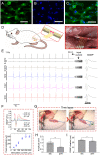Wide bandgap semiconductor nanomembranes as a long-term biointerface for flexible, implanted neuromodulator
- PMID: 35939711
- PMCID: PMC9388084
- DOI: 10.1073/pnas.2203287119
Wide bandgap semiconductor nanomembranes as a long-term biointerface for flexible, implanted neuromodulator
Abstract
Electrical neuron stimulation holds promise for treating chronic neurological disorders, including spinal cord injury, epilepsy, and Parkinson's disease. The implementation of ultrathin, flexible electrodes that can offer noninvasive attachment to soft neural tissues is a breakthrough for timely, continuous, programable, and spatial stimulations. With strict flexibility requirements in neural implanted stimulations, the use of conventional thick and bulky packages is no longer applicable, posing major technical issues such as short device lifetime and long-term stability. We introduce herein a concept of long-lived flexible neural electrodes using silicon carbide (SiC) nanomembranes as a faradic interface and thermal oxide thin films as an electrical barrier layer. The SiC nanomembranes were developed using a chemical vapor deposition (CVD) process at the wafer level, and thermal oxide was grown using a high-quality wet oxidation technique. The proposed material developments are highly scalable and compatible with MEMS technologies, facilitating the mass production of long-lived implanted bioelectrodes. Our experimental results showed excellent stability of the SiC/silicon dioxide (SiO2) bioelectronic system that can potentially last for several decades with well-maintained electronic properties in biofluid environments. We demonstrated the capability of the proposed material system for peripheral nerve stimulation in an animal model, showing muscle contraction responses comparable to those of a standard non-implanted nerve stimulation device. The design concept, scalable fabrication approach, and multimodal functionalities of SiC/SiO2 flexible electronics offer an exciting possibility for fundamental neuroscience studies, as well as for neural stimulation-based therapies.
Keywords: bioencapsulation; flexible electronics; implanted applications; long-term stability; neuron modulators.
Conflict of interest statement
The authors declare no competing interest.
Figures





Similar articles
-
Long-Lived, Transferred Crystalline Silicon Carbide Nanomembranes for Implantable Flexible Electronics.ACS Nano. 2019 Oct 22;13(10):11572-11581. doi: 10.1021/acsnano.9b05168. Epub 2019 Aug 26. ACS Nano. 2019. PMID: 31433939
-
Fundamental research on semiconductor SiC and its applications to power electronics.Proc Jpn Acad Ser B Phys Biol Sci. 2020;96(7):235-254. doi: 10.2183/pjab.96.018. Proc Jpn Acad Ser B Phys Biol Sci. 2020. PMID: 32788548 Free PMC article. Review.
-
Integrated, Transparent Silicon Carbide Electronics and Sensors for Radio Frequency Biomedical Therapy.ACS Nano. 2022 Jul 26;16(7):10890-10903. doi: 10.1021/acsnano.2c03188. Epub 2022 Jul 11. ACS Nano. 2022. PMID: 35816450 Free PMC article.
-
Flexible Electrode Arrays Based on a Wide Bandgap Semiconductors for Chronic Implantable Multiplexed Sensing and Heart Pacemakers.ACS Nano. 2025 Jan 14;19(1):1642-1659. doi: 10.1021/acsnano.4c15294. Epub 2025 Jan 3. ACS Nano. 2025. PMID: 39752298
-
Porous Silicon Carbide (SiC): A Chance for Improving Catalysts or Just Another Active-Phase Carrier?Chem Rev. 2021 Sep 8;121(17):10559-10665. doi: 10.1021/acs.chemrev.1c00269. Epub 2021 Jul 13. Chem Rev. 2021. PMID: 34255488 Review.
Cited by
-
Advances in electrode interface materials and modification technologies for brain-computer interfaces.Biomater Transl. 2023 Dec 28;4(4):213-233. doi: 10.12336/biomatertransl.2023.04.003. eCollection 2023. Biomater Transl. 2023. PMID: 38282708 Free PMC article. Review.
-
A Body-Temperature-Triggered In Situ Softening Peripheral Nerve Electrode for Chronic Robust Neuromodulation.Adv Sci (Weinh). 2025 Feb;12(5):e2412361. doi: 10.1002/advs.202412361. Epub 2024 Dec 6. Adv Sci (Weinh). 2025. PMID: 39639850 Free PMC article.
-
Flexible Mechanical Sensors for Plant Growth Monitoring: An Emerging Area for Smart Agriculture.Sensors (Basel). 2024 Dec 14;24(24):7995. doi: 10.3390/s24247995. Sensors (Basel). 2024. PMID: 39771731 Free PMC article.
-
Polyimide as a biomedical material: advantages and applications.Nanoscale Adv. 2024 Jul 4;6(17):4309-4324. doi: 10.1039/d4na00292j. eCollection 2024 Aug 20. Nanoscale Adv. 2024. PMID: 39170974 Free PMC article. Review.
-
Fully bioresorbable hybrid opto-electronic neural implant system for simultaneous electrophysiological recording and optogenetic stimulation.Nat Commun. 2024 Mar 6;15(1):2000. doi: 10.1038/s41467-024-45803-0. Nat Commun. 2024. PMID: 38448437 Free PMC article.
References
-
- Wagner F. B., et al. , Targeted neurotechnology restores walking in humans with spinal cord injury. Nature 563, 65–71 (2018). - PubMed
-
- Jones M. L., et al. , Activity-based therapy for recovery of walking in individuals with chronic spinal cord injury: Results from a randomized clinical trial. Arch. Phys. Med. Rehabil. 95, 2239–46.e2 (2014). - PubMed
-
- Someya T., Bao Z., Malliaras G. G., The rise of plastic bioelectronics. Nature 540, 379–385 (2016). - PubMed
Publication types
MeSH terms
Substances
LinkOut - more resources
Full Text Sources

